#cinematic retrospective
Explore tagged Tumblr posts
Text
Retrospective Essay: The Alien Franchise – A Journey Through Fear and Survival
Few film franchises can claim to have shaped science fiction and horror as profoundly as Alien. Since Ridley Scott’s original masterpiece premiered in 1979, the series has spanned over four decades, captivating audiences with its unique blend of terror, action, and existential musings. From claustrophobic corridors to sprawling alien worlds, each film in the franchise has experimented with tone…

View On WordPress
#Alien 3#Alien franchise#Alien movies#Alien: Covenant#Alien: Resurrection#Alien: Romulus#aliens#cinematic retrospective#cinematic themes#David Fincher#Film Analysis#franchise evolution#James Cameron#Michael Fassbender#movie review#Prometheus#Ridley Scott#sci-fi horror#Science Fiction#Xenomorph
0 notes
Text
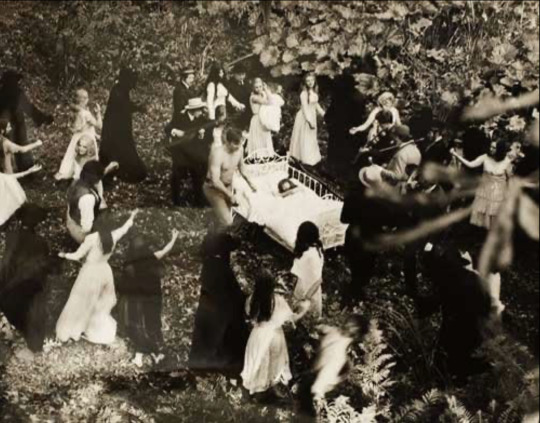
Valerie & Her Week of Wonders (1970) Dir. Jaromil Jireš
#valerie & her week of wonders#1970#1970s#adaptation#jaromil jireš#Czechoslovakian cinema#horror#retrospective#foreign language film#cinematic still#film still#stills
50 notes
·
View notes
Video
youtube
Black Widow(2021) DC & Marvel Retrospective/Reviews
#youtube#dc & marvel retrospective/reviews#marvel#marvel cinematic universe#black widow#black widow movie#black widow 2021#black widow 2021 movie#natasha romanoff#natasha romanov#mcu black widow#mcu natasha romanoff
3 notes
·
View notes
Text
Presented without comment:

#yeah he left me on ‘read’#in retrospect I should have led with the snail#mawwage#darsy’s cinematic life#yes yes it was a race not a fight
2 notes
·
View notes
Text
Revisiting my post from almost two years ago (feels like yesterday, honestly), just in celebration of the recent teaser for James Gunn's Superman! Gonna have a post on this in full, because I have...thoughts. Cautiously optimistic and enthusiastically concerned thoughts. I'll get to it. But yeah, feel free to give these a read if you'd like to see another proposed cinematic take on the Superman mythos!
The Superman Logs
You will believe a nerd can write...kinda.
Listed below are the links to my insane ramblings about the Man of Steel, the Last Son of Krypton, the Man of Tomorrow: Superman. To be specific, this began with an essay series on what I would do with a Superman film, were I given the reins to the DC Cinematic Universe instead of James Gunn. And from there, it sort of exploded. Feel free to start with the film essay series, or go ahead and check out the smaller essays on characters or films/series reviews and retrospectives. This is expanding all the time, but beware before you enter. This shit is LONG, real nerdy, and just generally a lot. But if you DO read anything presented here...well, thanks, I really, genuinely appreciate it. Hopefully you enjoy the ride!
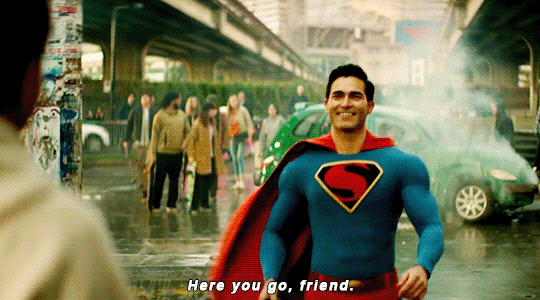
My DC Cinematic Universe: Superman
Part I: Why I Love Superman Part II: On Lois Lane Part III: The Kents Part IV: The 'Rents Part V: The...Frendts? Part VI: Lex Luthor Part VII: The Real Villains Part VIII: Superman's Rogues Gallery Part IX: The Story - Act One Part X: The Story (Acts Two and Three) Part XI: The Story - Climax Part XII: Hope... Part XIII: For The Future

Reviews and Retrospectives
Epilogue: My Adventures With Superman My Adventures With Superman: S2, Episodes 1 - 3
More coming soon!

Character Essays
Character Essay: Mr. Mxyzptlk
More coming soon!
#superman#superman 2025#dcu#my dcu#my dccu#my dc cinematic universe#dc cinematic universe#clark kent#david corenswet#lois lane#rachel brosnahan#retrospective#character essay#essay series#lex luthor#nicholas hoult#superman dc#dc comics#dc#dccu#james gunn#james gunn dcu
50 notes
·
View notes
Video
youtube
Blade(1998)Andres Pop Culture Guy Retrospective/Reviews
#youtube#blade#blade 25th anniversary#blade 1998 film#blade 25 years#marvel blade#marvel#marvel cinematic universe#marvel comics#marvel universe#andres pop culture guy retrospective/reviews
0 notes
Text


A One and A Two: Edward Yang Retrospective
#edward yang#A One and A Two: Edward Yang Retrospective#exhibit#exhibition#taipei fine arts museum#photography#cinematic#crt tv#x100f#fujifilm x100f#Lifestyle
0 notes
Text
archiveofourown.org
Fandom: Deadpool and Wolverine, Deadpool movies, Marvel Cinematic Universe
Chapter: 1/6
Rating: Explicit
Category: M/M
Warnings: Graphic Depictions of Violence
Relationships: Logan/Wade Wilson
Characters: Wade Wilson, Logan | Worst Wolverine, Dogpool | Mary Puppins, Laura Kinney, Blind Al, Vanessa Carlysle, Yukio, Ellie Phimister
Additional Tags: 5+1 Things, Idiots in Love, Canon-Typical Violence, sort of! probably not goign to ve very graphic actually, Horny Wade Wilson, Enemies to Friends to Lovers, Friends to Lovers, Fluff, Domestic Fluff, Angst, Humor, Banter, Soft Logan, Logan is Bad at Feelings, Protective Wade Wilson, Protective Logan, EVERYONE can tell they're in love EXCEPT them, a little bit of daddy kink
Summary:
In retrospect, it's pretty fuckin' obvious.
But Wade's an idiot and so is Logan, so... there you go. Everyone gets to tell them I told you so.
#deadpool and wolverine#deadpool 3#poolverine#deadclaws#deadpool x wolverine#deadpool#wade wilson#logan howlett#wolverine#deadpool fanfiction#fanfiction#idk what else to tag this as man#cross talks#my fic
28 notes
·
View notes
Text
chapter 141 thoughts!
The usual reminder: because of the content of this arc, I will unavoidably have to discuss CSA and topics related to it in this & future chapter reviews. I do not discuss them in great detail, but if you very understandably just aren't in the headspace for that, no hard feelings - look after yourself and I'll see you next time.
This chapter starts us off on the note of answering something I've been wondering for a while and confirming that Ai did, in fact, know that Hikaru was being abused by Airi. On the one hand, this feels like it should go without saying, since it answers the question of where Aqua would have gotten some of this info, but it feels strange to have this dropped on us in such a matter of fact way.
In general, I continue to be both baffled and impressed by Oshi no Ko's dedication to never showing characters learning or reacting to huge, status-quo altering pieces of information on screen lol. I think this is more a case of the movie's framing than the manga's - hard cutting from the HKAI exchange at the end of last chapter to the Ai & Airi confrontation is very cinematically appropriate - but it does bother me regardless. In isolation, I think it's fine and we get more than enough information about Ai's thoughts and feelings on the situation in the confrontation but it's nevertheless part of a pattern that's been going on for a long while now of important reveals and reactions to really huge pieces of information are happening entirely offscreen and are only told to the viewer in retrospect, or are backfilled into the story once Akasaka wants to make use of it. It's not a world-ending flaw or anything but I'm noticing it more and more and I think it's been harming the series more than it's helping.
That said, I do really like this confrontation Ai has with Airi. It definitely feels more like Ai speaking for Aqua than it does Ai herself speaking - the cold, straightforward way she addresses Airi pretty clearly mirrors the way Aqua spoke to the director on Akane's behalf back in LoveNow. Whether this is a case of Aqua using Ai as a mouthpiece or their similarities as mother and son coming out in a moment like this, I think it's interesting either way. Given what we learned about Ai's own abuse and her own history with narrowly avoided CSA, it makes total sense that upon learning someone she cares about was being similarly exploited by an adult that she would have some very strong feelings about it.
Airi's meltdown in response is also something I have mixed feelings on. As a piece of characterization in isolation, it's fascinating and I think it provides some important insight into how and why Airi was able to rationalize and justify her abuse of Hikaru to herself, even though she clearly knows it was objectively wrong. I honestly can't help but see parallels in the way she centers her own feelings and pain and uses that as justification for her actions with Ayumi, Ai's mother, who had a more subdued but emotionally similar breakdown when talking about her history with her daughter.
Ultimately, I do feel it adds more than it takes away - I would much rather see the story continue to humanize characters who could otherwise have just been left as uncomplicatedly black and white Evil People Doing Bad Things. People very rarely begin acting in cruel, exploitative or antisocial ways out of nowhere and I think the manga's story is better for highlighting that this is the case.
H O W E V E R. . . where my feelings become more negative is the talk that follows, but I have like a million things to say about that so I'll put a pin in it for now to not derail too badly.
Given how Airi responds here, I'm also suddenly very curious as to if this direct confrontation was what put an end to her abuse of Hikaru. It's hard for me to imagine her going back to it after being so directly called out and if that's the case, I can't help but wonder if this was the trigger for the HKAI romance. I already talked last chapter that there's some imagery already implying Hikaru views Ai as his light, which OnK thematically associates with the role of a savior in someone's life. If Ai really did manage to intervene and protect Hikaru from Airi's abuse, then that would have intensified those feelings one hundredfold.
holy shit akane AND miyako are back! wow, isn't it totally crazy that across the arcs where they could have contributed to and potentially resolved the conflicts at play they were just totally absent but now they're just reappearing without comment or reaction to any of that other shit!
As I mentioned before, I have really mixed feelings on this scene with Miyako and the others. In isolation, I do like it and I think it kind of brings into explicit text something that had been just floating around as vibes before, which is how absolutely symbiotic with misogyny and sexual exploitation the entertainment industry is. The way misogyny played into Ai's exploration was always a really fascinating part of her arc to me, but given that Akasaka at least publicly presents as a person without that sort of lived experience, I was curious as to how much was intentional and how much was accidental, just because of how surprising it was to see a man centering this sort of thing so thoroughly in his writing. This scene with Miyako makes it clear that it's something Akasaka absolutely wants to highlight and discuss in Oshi no Ko, to the point of him being willing to call out even likable and sympathetic characters like Taiki for casually taking part in and perpetuating it.
THAT SAID… I really don't like that this scene, accidentally or otherwise, ends up centering and discussing Airi's victimhood over Hikaru's. His story has always been an indictment of the way children, specifically, are at risk in the entertainment industry not just in terms of being exploited as workers, but in the ways that adults in power can and will use their positions of authority to do exactly what Airi has done. That is what needed to be discussed here; the way that Hikaru's abuse is in no way an isolated incident and how people like Airi will continue to get away with hurting children so long as the industry - and society at large - treats children like second-class citizens at best and commodities at worst. I do think this scene is trying to use Airi and Miyako's experiences as a jumping off point to talk about exploitation in general and the way a person's ability to say 'no' can be compromised by outside pressures but it talks so much and so exclusively about the experiences of young girls and adult women specifically that it's hard not to read it as the story placing more value - at least for now - in exploring Airi's perspective over Hikaru's and that just feels kind of grody to me.
The timeline of this chapter is also just… really weird? Given Frill's, uh, appearance at the end of the chapter I have to assume it's taking place right after she films her scene with Aqua last chapter but that makes no sense given where the Ai and Airi confrontation is placed…? My best guess is that the scene we get at the start is some kind of visualization of the script by the characters who are reading it but it's all still very needlessly confusing lol
frill just barging in with her tits out when she knew rbkn were waiting for her was so fucking funny though i gotta admit. weird ass lizard woman.
Her mentioning it was her own decision to do the scene like that is also shrimptresting because it seems to implicitly confirm that there is, thank god, SOME kind of intimacy coordinator on set that the cast are talking about these scenes with. I actually also think the level of trust and comfort between Aqua and Frill this implies is also really interesting…? In general, I've always really like the idea of AQFR friendship, so this is kind of making me daydream a bit about seeing more of one…
As for the ending… man, it's such transparent reaction bait that I can't really summon the energy to get annoyed LOL. At least we won't have to wait a whole extra week to see what it amounts to.
Weary as I am with the reaction bait cliffhangers, I am at least glad to see the story coming around to finally addressing the elephant in the room here. As the chapter end text points out in the Japanese versions of this chapter, a scene like this was an inevitability of playing Ai and Hikaru and it's been where I've expected to see the underlying tension that's been floating around AQRB's relationship since the past life reveal finally get drawn out and addressed. Given its placement in the story (ch 142 is only the second chapter of its corresponding volume) and the framing of that last page as more of a gag/punchline than a serious dramatic beat, I don't things are quite going to play out like Ruby seems to want, but I'm nevertheless curious as to wtf is even going to happen
Honestly, at this point, I kind of just want Akasaka to shit or get off the pot. If he's going to bring a topic like incest to the table, then I want him to actually have something to say about it that isn't just Ruby going 'kyaa oniichan' and acting like a fanservice imouto character from a harem anime. If we're going to have something like 'Ruby falls in love with her brother' actually happen in story, then I want to see how she feels about this, how she rationalizes it, how she expects this to play out when she and Aqua live in a society that by and large condemns incest and treats it as taboo. At the very least, give me something to dig into and examine and chew on that wouldn't have already felt dated during the mid 2010s little sister boom.
63 notes
·
View notes
Text
When you've watched as much anime as I have, you start to notice all the common little quirks and production choices that pop up between shows. One thing I've noticed? A lot of shows won't draw the characters' faces if they're far enough away from the camera. There'll just be a blank blob where their expressions would normally be because their expressions aren't the focus; the environment surrounding them is what's communicating the emotions of that particular animation cut, and your attention isn't going to be on their faces as a result, so why bother drawing them in? At this distance it's not like you could make out important details anyway.
It's a perfectly fine time-saving measure on its own- but as with every time-saving shortcut anime takes, it can easily go wrong. Vinland Saga's second season has a lot of faceless character shots in this style, but a lot of these shots have the characters too close to the camera, so their lack of face is incredibly noticeable. Seriously, watch season 2 and take a shot every time there's a shot where the faceless characters are close enough to the camera that it doesn't make sense for them to not have features. You'll be blackout drunk before the halfway mark.
And that's not even considering when a character has to move from far away to close-up in a single animation cut. What happens when a character starts far enough from the camera that their features aren't drawn, but ends close enough to the camera that we need to see their face? Do the lines just pop up out of nowhere at a certain point? Do we see their face literally loading in as they get closer and closer? It seems like there's no possible way to make that Not Extremely Awkward.
And once again, it's the goddamn stepsister anime that makes it look like child's play.

There's this shot right at the beginning of episode 4 of Days With My Stepsister where the main character is walking toward the camera down the street. As you can tell from this picture, he's far enough away that the animators haven't drawn his face. But by the end of this shot, he'll be close enough to the camera that we will need to see his face. So how do they handle that transition?
Well, right around the point that his features would start popping in, he goes to wipe the sweat off his forehead in the summer heat.

And by the time he takes his hand down...

His face is already fully loaded in.

It's such a simple little trick. But it's so goddamn clever. Just by using his hand to block his face from the camera, the animators are able to seamlessly transition from a featureless far shot to a full-faced close-up without having to awkwardly show us his face appearing out of nowhere. It seems so obvious in retrospect that I can't believe I haven't seen it done anywhere else. And this is just one of countless little choices this show makes in every single episode to turn its modest production values into something genuinely cinematic and lived-in. This is Soudai Ueno's first work as lead director, and I dearly hope it won't be his last; if he keeps this kind of work up, there's no telling how good his next show will be.
21 notes
·
View notes
Text
I found a weird old Gamecube survival horror game??? Can you help??
I’ve recently started collecting older video games, specifically all the survival horror games that I was too afraid to play as a kid. Now that I’m older and have a salaried job, it’s nice to be able to court that younger version of me and buy all the stuff my family couldn’t afford. Plus the games are fun. Everything from Resident Evil to Rule of Rose, Fatal Frame to Parasite Eve. I love being scared and these games work their hardest to do it and sometimes succeed.
Before I play them, I like to go on youtube and watch retrospectives, reviews, and old ads for them, so I can sort of get settled into the headspace and learn about the creation of them. But there’s one that I’ve stumbled on that I’m unable to find anything about. Almost like it came out of nowhere.
I found this game at a used game, movie, and music store just off the red line in Chicago. It’s called Soul Cemetery for the Gamecube. A survival horror game about a detective returning to their hometown to investigate the mysterious death of her father. It’s very obviously inspired by Resident Evil, featuring the tank controls, fixed camera angles, and similar graphics, not to mention the focus on zombies which wander the town. There’s also some Silent Hill influence with a heavy use of snow (instead of fog) and ambient music throughout.

It seemed like a very generic sort of game after the opening cinematic and wandering around the opening area, but then it started to reveal itself as something more. The controls were straight forward but also had some interesting things about them. You aim and shoot like in RE, but there’s also a button to “hum,” which makes the detective slow her run to a walk and hum a tune, which changes with each area and sometimes changes within each area depending on exactly where you stand.
There’s also a dedicated “smoke” button, which plays a unique (albeit short) cutscene where the detective smokes a cigarette and says a little something about the area, or what just happened. It almost feels like the journal mechanic that games like Life is Strange have, where the character recaps the last chapter in their own words, only you get to control when it happens and how often.
Both of these things kinda took me off guard and drew me into the game in a way I didn’t expect. There are no save rooms or safe rooms like in a lot of survival horror games, so these two things were like getting a break for the spooky scary stuff whenever I needed it, while also getting to hear the thoughts of the character.
This got kinda freaky when the detective started saying things about me during these moments. The game must read your memory card and system data or something because the further I got into the game, whenever she’d smoke she’d say stuff to me about how late I was up, or about the weather (possibly reading the month??? Idk if Gamecubes have location data). In the light of day these things aren’t that scary ig, but after getting killed by zombies after playing till 4 a.m. it was definitely giving me goosebumps.
It was extra creepy when the detective would do these things without being prompted. The further I got into the game, the more she would indulge in humming or smoking without me pressing the buttons. At first I thought maybe my hand slipped, but no, it’s almost like she has a mind of her own. And these self-indulgent moments were often the scariest.
I played through the entire thing in one sitting, it was maybe 5-6 hours. There were some obvious levels included in a lot of survival horror games, like a spooky motel with zombies, a dark forest with this weird moon spirit creature who is like the main bad guy of the game, and an empty town center where there’s a boss battle. About halfway through, the detective finds herself at her childhood home and that’s when shit really started to freak me out. I don’t know how to explain it other than her house had the same layout as mine? Maybe it’s just a coincidence because the game takes place in an unnamed midwest town, and maybe the houses here are just copy-pasted anyways. But it was spooky. Her living room was my living room, her bedroom was mine, the kitchen was mine. Even the spooky stairway into the basement was in the same place.
Back in her parents room, her mom is a zombie. There’s no music. Just the looped MP3 of the zombie groans. Whenever you press the button to aim, the detective would hesitate and tell me not to do it. It was only after the mom had attacked and killed me once that I could actually return to the room and shoot the zombie. Immediately after, the detective took control and started humming this really broken, solemn tune. It felt so recognizable but I can’t figure it out. I did my best to record it here:
It’s been stuck in my head ever since.
After the run in with the mom zombie, the detective continues humming that tune, allowing me to walk slowly through the house. I returned to her bedroom and was able to “interact” with her childhood bed. The detective climbs in, the humming breaking up more and more until she falls asleep.
There’s a few esoteric and surreal images that flash on the screen. I didn’t expect them, so I couldn’t take pictures, and when I went and played through the game again, this entire section didn’t happen. Idk if it’s just like the order of events was different, or if it was how I killed the mom or how I explore after? Idk. But the images were these brutal close-ups of the mom zombie. Like, real photos, not just rendered. There were startling, and even if I can’t get them to pop up again, I feel like they’re still fresh in my mind.
The detective wakes up in her childhood bedroom after a second and is different. She’s a child. Her character model is smaller, she doesn't have her gun, and her entire control scheme is different. Most of the buttons are replaced with the “hum” thing, which has her doing that same haunting hum from before. As a child, she can still wander around the rest of the town, and it’s still overrun with zombies, now there’s just noway for her to defend herself.
I felt kind of stuck and frustrated with this as the zombies kept killing me and I didn’t like hearing the MP3 child scream over and over again, so eventually I turned the Gamecube off and on, and when the game loaded up, the detective woke up in her childhood bed as an adult, like none of that stuff happened. I was able to continue the game but was unable to beat the final boss. I think there was something I had to do as a child to be able to? But I don’t know. The game was very confusing at that point and, like I said, when I tried to replay it, the child-thing didn’t even happen.
I think if the game has a guide or even just, like, any information online I could have made sense of it. It’s a weird take on survival horror that really did get under my skin, I just wish I could finish it, or at least figure out what some of the weird stuff in it was doing or trying to do. If you played this game when you were younger, were there any guides you followed? Or do you remember anything? The only thing I was able to find was a shitty scan of the game manual, but even that I’m having a hard time deciphering…
Any help is appreciated!
#gamecube#survival horror#video games#lost media#scary games#creepypasta#soul cemetery#resident evil#clock tower 3#rule of rose#silent hill#game help#missing media
13 notes
·
View notes
Text
Legacies of the Black Female Experience in Black Horror: Eve’s Bayou (1997) by Monica Benros-DeBarros

Eve's Bayou (1997) - Copyright Image IMDb
Saturday, October 26, 2024
This week, while re-watching Kasi Lemmon’s Eve’s Bayou (1997) for purely academic reasons, I was struck by the way the narrative-told from the adult character Eve’s point of view-allows for a nuanced examination of truth and perception. I enjoyed the way the story was told from a women’s point of view. You know when you watch a film and see it one way, but then when you re-watch there are some surprises you may not have caught, and it changes the meaning of a film for you. Well, that’s what re-watching Eve’s Bayou does for me.


Images © Essence 2011
In looking at the film retrospectively, it was released in late 1990s, I realized it was at a time when the third wave of feminism was hitting our nation. Ideals of female empowerment were shifting and meant that much of the conversations that dominated the culture were around views of women taking back their sexuality. Back when I watched this originally, I was not connecting the themes to my feminist voice. The film challenges this view spectacularly, particularly in relation to gender dynamics and the consequences of family secrets. I especially loved the way the themes of familial relationships and the exploration of Black identity are weaved together within the realms of Creole folklore.
Lemmon’s offers distinctive viewpoint on the Black “girl” and Black “woman” experiences, especially as seen through the lens of the Batiste family. Storytelling of the film centers on the experiences of the girls and the women, something that wasn’t really happening in film at the time, which actively questions and challenges the conventional narratives that frequently marginalize women’s voices; not to mention Black voices. This emphasis on female agency and perspective represented a refreshing shift from conventional horror and film tropes of the era, allowing us to engage with the characters in a more profound, emotional manner. The Black female characters I found to be relatable, encourage me to contemplate my own identity and life experiences.

Image © Criteron 2022
In thinking of Kasi Lemmon’s message in Eve’s Bayou, it centers on recognizing and appreciating the experiences of Black women, alongside the intricate nature of memory and trauma. The black-and-white imagery in Eve’s Bayou, which I had not previously considered as part of the narrative, highlights the unreliability of memory. The film encourages us to reflect on the ways in which trauma influences both our individual and shared histories. I feel this theme may resonate with several individuals, reflecting the struggles faced by those confronting their own histories, especially Black history and the enduring legacy of slavery. Given my interest in the supernatural, I was impressed with the way Lemmon's weaved together elements of voodoo emphasizing the importance of Black cultural folklore, while also showcasing storytelling as a vital avenue for healing and self-discovery.

Eve's Bayou (1997) - Copyright Image IMDb
Eve's Bayou is one of those tales that speaks to a lot of people's own experience with memory, cultural identity, and familial relationships. Some individuals might see similarities between their own experiences and the challenges encountered by the Batiste family, especially in dealing with the impacts of trauma and the quest for comprehension within their own personal histories. Whenever I watch Eve’s Bayou, I’m filled with memories of my family, the rituals, and cultural practices that are personally significant, emphasizing the notion that these stories are not merely cinematic but are deeply intertwined with our lived experiences.
#black stories#black art#black liberation#black history#black literature#black women#black woman magic#black tumblr#academia
11 notes
·
View notes
Text
Malcolm’s epiphany constructs a narrative frame—an explanation of the condition or source of the narrative. But this is a frame or condition we only learn about at film’s end, and is thus a terminal frame, or a buried frame, a late embedding of one narrative level by another, or a narrative that takes the “form of a vision” from which the reader or viewer is “rudely ejected” at narrative’s end (Fludernik 29). In American Psycho, A Beautiful Mind, Cypher, eXistenZ, Fight Club, Hide and Seek, Identity, The Jacket, The Machinist, Mulholland Drive, The Number 23, The Others, Premonition, The Prestige, Secret Window, Shutter Island, The Spanish Prisoner, Third Person, Unknown, The Usual Suspects, Vanilla Sky, and so on, the central character at film’s end is revealed to be spectral, virtual, imagined, traumatized, conned, delusional, or in some other way compromised as a credible witness to, or participant in, the narrative’s events. In most of these films, what we thought to be objective narration turns out to have been thoroughly subjective, as a “deeper diegetic ground is inserted below the level we took for the baseline of reality” (Stewart 143). In several of these films we encounter the millennial trope I label retrospective revision: a montage sequence near the end of the movie in which we review earlier scenes, now recognizing the blind-spots, freshly cognizant of how we were deceived and how completely we should revise our understanding of the entire film. Like a transmedial franchise in which the narrative is just so much data to be used, reformatted, and reused, the ending of The Sixth Sense goes about repurposing the film itself, remixing and recontextualizing earlier scenes, a narrative parallel to the new fluidity of the moving image; it can go back and remix itself, even as it directs us forward to acquire and re-watch the movie in its post-theatrical life. This is a new formal logic within popular cinematic narrative: reconfiguration, revision, and remixing.
Audiences today have come to expect final plot twists to be thoroughly integrated into the structure of the film: “The ending can’t seem arbitrary, non sequitur, or tacked on; it should flow naturally and organically (if only in retrospect) from the rest of the story” (Susman). Twist movies today are often made to repay multiple viewings, to enter into a “culture of replay,” in which “the already seen and heard” becomes an “emblematic feature of the media business” (Klinger, “Becoming Cult” 4). This is a type of movie that viewers are encouraged to analyze, reflect back on, likely re-view, and perhaps even read about online in order to fully appreciate the intricacies of the story’s narration. This marks a stark departure from traditional expectations—as Charles Ramírez Berg writes, “For nearly a century now, the poetics of film narration was based on the need to be completely legible to one-time viewers” (31). Writers and producers of these films, in a “cognitive arms race” (Max) with audiences, begin to void long-held narrative contracts. They draft new arrangements with new rules that take into account the attainability and interactivity of contemporary cinema, or all of the digital means that encourage deep immersion in story worlds and negate the primacy of the theater. These movies are internet- and “DVD-enabled,” Thomas Elsaesser writes, their narrative structures determined in part by the technologies audiences use to consume them (“Mind-Game” 38).
—J Lavender-Smith, The New Reflexivity: Puzzle Films, Found Footage, and Cinematic Narration in the Digital Age, 2016. Emphasis mine.
18 notes
·
View notes
Text
mary murdock retrospective (10k)
i loosely compiled a bunch of mary ficlets on here to put on ao3! the mary murdock cinematic universe has brought me a lot of comfort throughout many years. @amaronith gave me a prompt that sent me into a baby spiral briefly and became the original fic and it's just been little scrappy bits from then.
the tag for her on here is "mary murdock light of my life" for a reason. she is truly the oc of all ocs.
here on ao3
16 notes
·
View notes
Text
Edward Teach: How to (de)Construct a Legendary Villain
The show introduces us to the legendary Blackbeard as a traditional Hollywood villain. He’s positioned, specifically, as Bond villain Ernst Stavro Blofeld, head of the global criminal organization SPECTRE.
This character came to define the trope of the criminal mastermind, including the trope of never showing the villain’s face. The chair obscuring Ed’s body while his minion takes orders from across the desk is classic Blofeld.
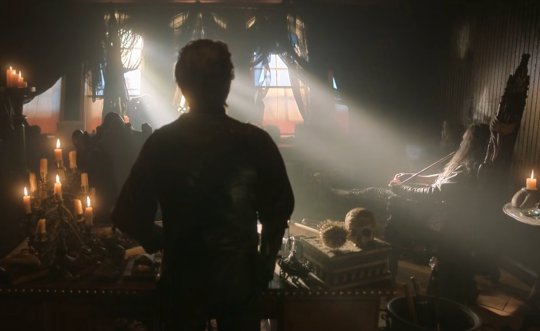
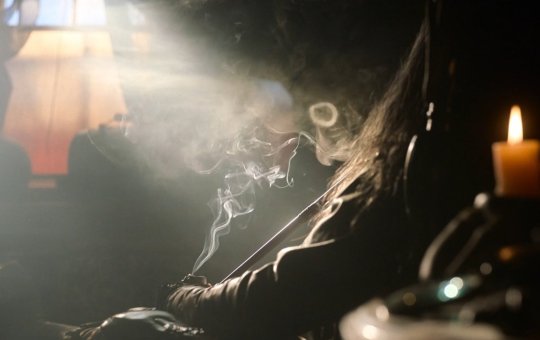

Along with Black Pete’s story, this is meant to pour in information about and expectations for Blackbeard in the short three episode buildup to his reveal: He’s big news, he’s bad news, and he’s the undisputed big dog whose underlings are cogs in his evil schemes.
Yet even in his first scene, the show begins to highlight the artifice at play and humanize Blackbeard and his subordinate.
Izzy is doing his level best to play the sufficiently professional henchman. Edward flirts with him until he’s forced to drop the pretense, his henchman act collapsing into an exhausted and familiar “Oh, Edward, can't I just send the boys?”
And, if we look closely in retrospect, the reason Ed doesn’t turn to the camera is that his leg is elevated to give relief to its nagging knee injury. There’s a cane in the bin in the foreground beside Izzy. These stereotypical trappings of villainy are partly a product of Edward’s high seas career wearing his body down.
On to Episode 4
Episode 4 isn’t a significant departure from any other day at SPECTRE flotilla headquarters for Edward. Yes, he meets a fun new guy. He also shows off what kind of brilliance is routinely demanded of him by his profession (of being a criminal mastermind) day in and day out, even if he hits a hitch. The emotional beat of the episode is exposing how this intense workplace grind is wearing him down.
Next, he decides he’ll sail with that fun new guy, murder him, desecrate his corpse and take his identity. The kind of nefarious scheme a pro would expect of himself.
The subsequent plot, then, does not come out of the idea that Ed, as Blackbeard, is any less than a man who’s achieved the pinnacle of Big Bad attainment, who in conversation with his subordinate checks off on killing entire crews as part of “the uzsh.” He really is that good, and Stede really would have made the perfect and unwitting mark Ed identifies him for.
Two things are true at once:
Blackbeard is his world’s all time pirate villain overseeing the dispatching of countless lives (we see the population of a whole merchant vessel butchered just in Episode 5 — but laugh, because the sequence is shot through with camp), and
Ed Teach “works for Blackbeard.”
Blackbeard isn’t who Ed is but a product of Ed’s theatrical skills.
The show has, already, in Episode 4 cast a realistic light on the inevitable psychological toll of being the Big Bad mastermind keeping yourself at peak performance all the time.
On to Episode 6
In Episode 6, the show deconstructs how one man, who has one gun and one knife just like everyone else, could feasibly construct such a legend.
This is, at the same time, a meta interrogation of how much effort a man like Blofeld and his infinite villainous counterparts across all cinema would have to actually put in to maintain their seemingly effortless style.
Here, the answer is Ed is a theatre kid at heart, relying on all the same techniques the real life crew themselves are using to bring us the show.
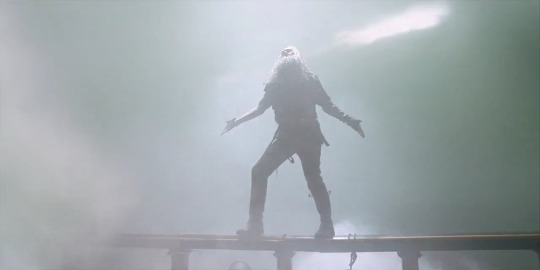
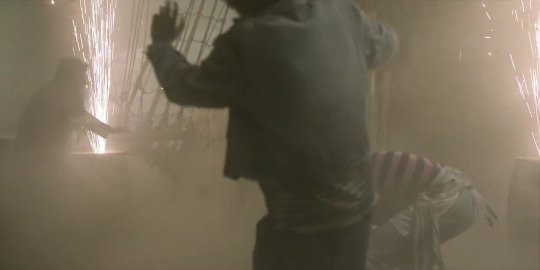
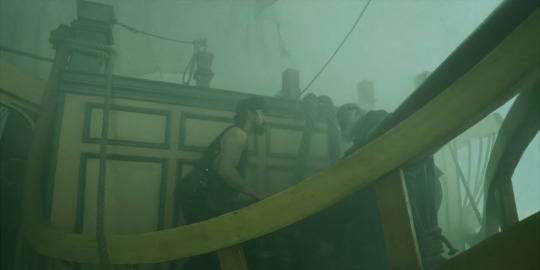
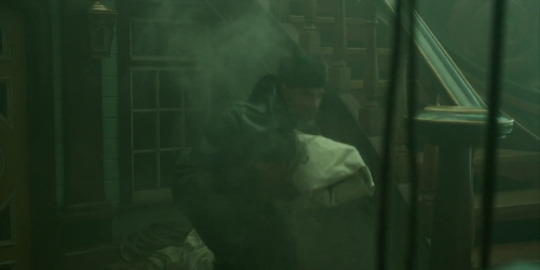
We’re given a scene of Ed seemingly teleporting around a clouded ship, delivering cinematic lines like “Flee and survive, or face me and burn!”
Barrels of sparklers stream flash powder into the air. The unnatural fog turns out to be the product of stagehands hard at work behind the scenes. We can extrapolate the flashes of lighting were likely, seeing as we can’t assume stage lights, the product of even more flash powder prepped in the style of old time photography.
Ed ends up in an elaborate harness. One that Izzy’s doubtlessly removed him from countless times, as he reminds Ed if they don’t work together Ed’s balls will chafe. (Ostensibly, this all used to go smoother before stress aged their relationship to the point of its present squabbles.)
Now we can spy back earlier in the show and see even in Episode 3 they were employing theatrics.
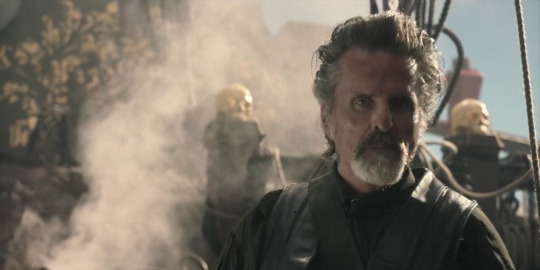
The smoke steaming behind Izzy as he fixes his spyglass on the Revenge isn’t mysteriously atmospheric. It’s from a big cauldron kept stoked on the deck of the ship, the handle of which peeks through. It’s a constant effort to keep the Queen Anne billowing across the ocean.
And Forward to the End...
Ed goes through multiple phases of trying on different Eds in the next four episodes. From living as tea with seven sugars Ed, to deciding he needs to physically move on if he’s not going to ice this guy but being prompted by Lucius to explore being “being in a relationship Ed,” to us seeing Jack’s Ed and his ability to relish brotivities, to stripped down Ed on the beach, a blank slate now able to open himself to considering what to paint there, to Ed choosing what to paint there.
Unfortunately, while it’s a new work, it's a dark one.
Having been rejected by Stede and Izzy successively as they see him trying out tidying house, become upset for individual reasons, and walk out of the room in nearly identical scenes, Ed takes stock of what he has left and what capacities in his repertoire will assure his future security.
We now see Ed pinning (stabbing) up a picture of the archetype he’s going to take on. This is Ed in his make-up trailer, looking to a character design by a concept artist and building a costume around it.



Grease paint, sword earring, jacket shrugged back on, full gloves, and, we see later, Stede's black cravat tight around his neck as @speckled-jim describes (and discusses further here) “like the albatross of Ancient Mariner fame,” reminding him that love itself can be a burden and to never allow himself to be that vulnerable again.
This new Blackbeard variant cuts a genius, poetic, unmistakably more dangerous image than the comparatively relaxed tough biker pirate we first met.
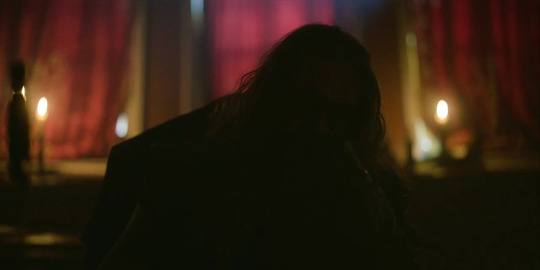

His newer, dialed up villainous persona, the Kraken, is face revealed with, among the many cinematic variations on the trope, what tightly resembles another more recent Blofeld shot, at once telegraphing this Ed is the Big Bad again and reminding us that being any Big Bad is a high camp performance.
The seams are already fraying. Fang and Ed are both shown drinking heavily to help cast off their sympathies for their recent associates and loose their MUAHAHAHAHA laughter. Already, before this scene, Izzy’s “Blackbeard is himself again!” is paired with the manic smile of a man who knows that whoever the new boss is, it’s not the original Blackbeard and he's in over his head.
But the three of them cut imposing figures on deck, and the future will tell if the movie magic holds.

Errata
Why would they think "Blofeld"?
It might be SPECTRE's trademark giant octopus.

126 notes
·
View notes
Text
Amplification of semiotic particles through a dynamic cinematic music video
Hey everyone! Today I'll try to thoroughly explain the use of amplification in music videos and as a relevant example I've decided to use one of my favorite artists during my teenage years, NF ! NF in particular always made sure there always is a cinematic aspect to his music videos. Iconic lyrics, carefully crafted intrinsic sentences and aspects to the diegesis of the message he wants to tell throughout each of his video clips and songs, yet so cinematically well used. There is a genuine need for the signifier to not lose sight of how the signified may be perceived by the audience and yet NF manages to connect the semiotics to his music videos through amplification of illustration ! I'll use one of the video clips of his latest album to demonstrate my point, I'll link the clip right here ! The name of this song is Hope.
youtube
Throughout the clip, many semiotic elements and concepts can be observed to provide concrete elements to this music clip but I'll start with the basics of what NF tried to achieve as an artist when it comes to his music videos. It is important to be aware of the fact that he strives for his music videos to be as cinematographic as possible, any of his music videos will most likely have elements of illustration and therefore something "deep" or "real" behind it for his fans even though this seems silly it is the way he brands his music and I do find it to be admirable to be as authentic as he is. Hope (the name of this song as previously mentioned) is about self-reflection and a message to NF himself, he literally talks to himself through the lyrics, back vocals and visual allowing to show the voices he is constantly hearing, reminiscing of his actions, words and past deeds. I will not further develop about the meaning of every single sequence in this music video as it is not the only purpose of this post, otherwise I would gladly spend many lines describing every references to his music in itself, all is needed to know in order to understand this post has been explained previously. Now that I've explained what I meant through his relationship with the diegesis, I'll emphasize the meaning of amplification used by illustration. The visual allows to further accentuate the intensity he wishes for the lyrics to have, the use of his face as a hook for this particular song creates more than a simple emphasis as I've explained previously, NF is directly talking to himself, he's confiding in the listener and therefore himself all he did in vain. Retrospection is illustrated by the symbolisation of him dressed in two colours in this music video, black and white representing respectively his current self and past self. Such icon demonstrates the contrast of the lyrics indeed but the parallelism used to embody the earworm rhythmic portraying the visual narractive as intrinsic to the song persuades the listener to the vision presented instead of the diegetic possibly imagined by the audience. While the visual parralels the rhythm and movements of the camera, the signifier may be confused as to what is signified. It is understandable that the complexity of coherence when it comes to musical, lyrical and visual meanings can be undermined considering the variety of contexts it can be perceived in. But I would like to argue that in the case of NF he manages to have a cohesive and catchy cinematography that allows amplification of the repeated semiotic particles to create a signified that corresponds to the signifier ! The narrative of the diegesis is shown through the use of amplification of many little semiotic elements previously explained and this illustration of the whole allows for NF to create a clear and cohesive rhythmic pattern accompanied by his voice, back vocals and lyrics following the intensity of the instruments used. This cohesive and fascinating whole brings to life this music video. Furthermore, it really has a stunning cinematography compared to some other rappers, interestingly enough, it has an earworm rhythm despite not even having a lyrical hook ! I do believe this is worth mentioning due to the fact that hooks have always been the attention seeker the music industry always thought of essential to any popular songs. Do you know of other artists using such concepts to create such an impressive cinematography ? In any case, see you next week for the next post :)
8 notes
·
View notes